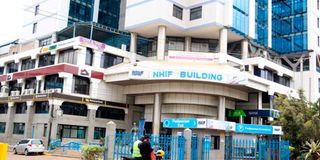NHIF nets Sh9.5bn from Edu-Afya plan

The NHIF building in Nairobi.
The National Hospital Insurance Fund (NHIF) has pocketed Sh9.5 billion from the government in four years under the Edu-Afya medical scheme in public secondary schools.
Documents presented in Parliament indicate that between 2019 and 2022, the fund was paid Sh9,550, 119, 795 from the scheme.
In 2019, the fund was paid claims amounting to Sh2,495, 236, 335; in 2020, the fund got Sh1,177,049,274; in 2021, it got Sh2, 650, 741, 755; while in 2022, the fund raked in Sh3,227, 092,341.
According to the documents presented by the fund, a total of 3.4 million students drawn from the 47 counties are currently registered under the scheme.
Some of the counties with the highest number of students registered under the scheme include Kakamega (189,119), Bungoma (175,624), Nakuru (158,515), Kiambu (140,690), Kisii (127,640), Homa Bay (122,477), Makueni (122,467), Meru (122,177), Murang’a (121,177) and Siaya (116,826)
A summary of the claims per county for the period January-December 2022 indicates that Homa Bay had the highest amount at Sh275 million, Siaya (Sh240 million), Kakamega (Sh215 million), Nairobi (Sh214 million), Kisumu (203 million) while Bungoma had Sh202 million as total claims for the year.
Other counties that also had highest claims in 2022 include Kisii with Sh159 million, Migori, (Sh157 million), Meru (Sh126 million), Nyamira (Sh118 million) and Uasin Gishu (Sh103 million).
Ms Joyce Cherono has petitioned Parliament calling on MPs to intervene on the poor implementation of the programme, saying the uptake of the initiative is still low due to poor communication, awareness and insufficient guidelines from NHIF.
The fund’s acting CEO Samson Kuhora dismissed the petitioner’s assertions.
“Sensitization exercises are conducted jointly by the Ministry of Education and NHIF in all counties targeting principals, teachers responsible for Nemis, parents’ associations representatives, county directors of education and other Ministry of Education officials,” Mr Kuhora said.
He told MPs in order to ensure success of the scheme, the fund jointly with the Education ministry, conducts an annual evaluation exercise with all stakeholders in order to get feedback on implementation of the programme.
“A survey is done via questionnaires filled by the school principals, health care providers, parents and students,” he said.
Launched in 2017 by then President Uhuru Kenyatta, the initiative has led to an increase in health budgetary allocations to the tune of Sh4 billion annually based on a premium of Sh1, 350 per student per year.
Also Read: Probe unearths abuse of NHIF services
The medical scheme was rolled out with the aim of improving quality health outcomes of students, reducing absenteeism and to reduce the out-of-pocket health expenditure by parents .
The Edu-Afya benefit package is comprehensive and includes outpatient, inpatient, surgical, oncology, radiology, renal dialysis, optical, dental, overseas treatment, emergency road ambulance and emergency air rescue.
“When a student visits a health care provider, the system used for identification and billing in the hospital is the NHIF system. All providers use the NHIF portal for identification of Edu-Afya beneficiaries and for billing,” the Mr Kuhora told MPs.
The public petitions committee is expected to table its report on the future of the initiative on May 17





